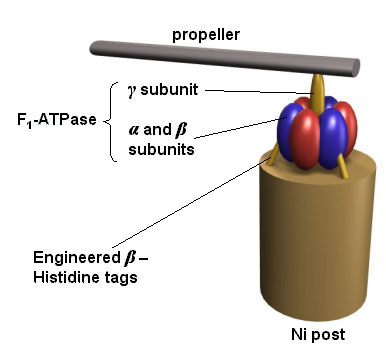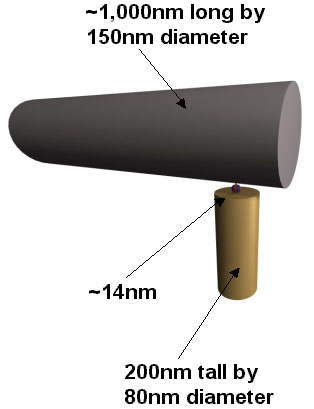Nanotechnology:
A Brief Overview
| BIOLOGICAL HIJACKING | |
|
One very promising avenue in nanotechnology is the idea of imitating, or down right stealing, designs found in nature. Nature has devised (evolved) countless engineering solutions to nanoscale problems, often finding extremely efficient and powerful resolutions. By studying nature, we can learn much about how to engineer devices at the nanoscale. By hijacking natural systems for our own uses (such as using viruses to do the genetic engineering for us), we may be able to create powerful new technologies with (comparatively) little work.
|
|
| MOTOR PROTEINS | |
|
One very neat example of taking biological systems into human control has been published by Carlo Montemagno.(1) The F1 component of ATPase (a naturally occurring protein aggregate) can act as a biological motor, using up ATP in order to rotate its' gamma sub-unit. The work here involved many steps. First, an array of nickel posts were lithographically defined on a substrate. Then, ATPase was genetically engineered so that the bottom of the beta subunit was decorated with a histidine tag, which caused the ATPase to preferentially sit on the nickel posts, and moreover to sit with the gamma subunit pointing upwards. The tog of the gamma subunit was also engineered to contain a cysteine group. Lithographically defined metal bars, coated with His-rich peptides, were introduced into the solution. The affinity of the Cys group for His-rich peptides caused the metal bars to attach to the end of the gamma subunits. Thus, lithographically defined posts (thus addressable from the macroscopic regime), had motor proteins selectively attached. Metal propellers were then attached to the motors. When ATP was introduced into the solution, the motors activated, rotating their propellers. The rotation of the propellers was easily controlled via the concentration of ATP in solution.
What is also startling is the size scales involved. The propeller was 1micron long and 150nm in diameter, but ATPase is an aggregate only 14nm in diameter! The propellers were spun at about 5Hz, showing that incredibly small, molecule-sized, devices can do quite a bit of work for their size (and with a very low failure rate, once they begin operating). The aspect ratio is remarkable: this is equivalent to a grown man spinning a solid metal bar 140m in length and 20m in diameter around five times a second (and doing it in the equivalent of molasses, when one considers the nature of fluid dynamics at that size scale). This comparison, of course, is not quite fair. Ants, for instance, can lift many times their body weight, whereas humans cannot. This is not because ant limbs are better designed than human limbs (indeed both are marvels of engineering), but because of the nature of scaling laws. Because volume and area, for instance, do not scale in the same way, a given cross-sectional area of muscle has proportionally more strength as it reduces in size. The nano-realm exaggerates these effects considerably. Many of the forces which are dominant are our size scale are essentially negligible at the nano-realm (gravity, for instance). ATPase, however, shows the true power of devices able to operate in the nano-regime (able, for instance, to easily manipulate loads hundreds of times their size). Below is a schematic of the setup with the various components shown to scale:
Because the propeller is so large, it can actually be resolved optically. Thus, Montemagno's group was able to obtain video footage of the device in operation. More details can be found in the original papers. As with many of the examples here, this device is a proof of principle. After all, it doesn't do anything. Moreover, only some of the posts had devices assembled onto them. Clearly, much optimization is required to generate actual technology, but the possibility of short-cutting the technological evolution curve by borrowing from nature should not be ignored.
|
|
| REFERENCES | |
|
|
|
|
|

